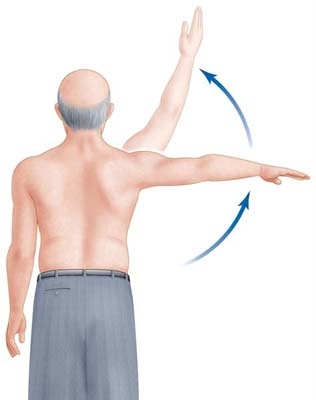Test Item Cluster - Full-Thickness Rotator Cuff Tear: Difference between revisions
m (New page: = '''Purpose'''<br> = To test the presence of a shoulder full-thickness rotator cuff tear using the [http://www.physio-pedia.com/index.php5?title=Codman%27s_Test The Drop-Arm Sign], ...) |
mNo edit summary |
||
| Line 22: | Line 22: | ||
<br> <u>The Painful Arc Sign</u> | <br> <u>The Painful Arc Sign</u> | ||
<u></u>Patient fully elevates the arm along the scapular plane and then slowly reverses the motion. If patient experiences pain between 60° and 120° of range of motion, the test is considered positive.<br> | |||
<u></u> | |||
<u>[[Image:Painful_arc.jpg]]</u> | |||
<u></u> | <u></u> | ||
Revision as of 07:29, 14 December 2009
Purpose
[edit | edit source]
To test the presence of a shoulder full-thickness rotator cuff tear using the The Drop-Arm Sign, The Painful Arc Sign, and the Infraspinatus Muscle Test.
Evidence[edit | edit source]
Based on the Park et al[1] study, the combination of the following 3 special tests have produced the highest post-test probability to diagnose a full-thickness rotator cuff tear:
- The Drop-Arm Sign
- The Painful Arc Sign
- Infraspinatus Muscle Test
The study concluded that if all 3 tests were positive, the probabibility of the patient having a full-thickness rotator cuff tear is 91%.[1]
Description and Illustrations
[edit | edit source]
The Drop-Arm Sign
Patient actively elevates the arm in the scapular plane and then slowly reverses the motion. A positive test is defined as the patient experiencing pain during the activity or that the arm suddenly drops.
The Painful Arc Sign
Patient fully elevates the arm along the scapular plane and then slowly reverses the motion. If patient experiences pain between 60° and 120° of range of motion, the test is considered positive.
Evidence[edit | edit source]
Flynn et al[2] developed a clinical prediction rule to identify low back patient that would benefit from the above described spinal manipulation technique. Out of 71 patients that participated, 32 had success with the manipulation intervention. The following 5 variables were identified to form a clinical prediction rule for patients with low back pain likely to respond favorably to spinal manipulation:
- Duration of symptoms < 16 days
- FABQ work subscale score < 19
- At least one hip with > 35° of internal rotation range of motion
- Hypomobility in the lumbar spine
- No symptoms distal to the knee
Based on the number of these variables present, the study calculated the probabilities of the manipulation being successful. It concluded that a patient presenting with 4 out of the 5 variables would have a probability of 95%, but even if 1 out of 5 variables were present the likelihood of the manipulation being successful is 46%. Table 1 is taken from the Flynn et al study and illustrates the clinical prediction rule and the probabilities based on the number of variables present.[2]
Table 1
References[edit | edit source]
- Park HB, Yokota A, Gill HS, El RG, McFarland EG. Diagnostic accuracy of clinical tests for the different degrees of subacromial impingement syndrome. J Bone Joint Surg Am 2005 July;87(7):1446-55.
- Cleland JA, Fritz JM, Whitman JM, Childs JD, Palmer JA. The use of a lumbar spine manipulation technique by physical therapists in patients who satisfy a clinical prediction rule: a case series. J Orthop Sports Phys Ther. 2006 Apr;36(4):209-14.www.ncbi.nlm.nih.gov/pubmed/16676870
- ↑ 1.0 1.1 Park HB, Yokota A, Gill HS, El RG, McFarland EG. Diagnostic accuracy of clinical tests for the different degrees of subacromial impingement syndrome. J Bone Joint Surg AmfckLR2005 July;87(7):1446-55. Cite error: Invalid
<ref>tag; name "Park" defined multiple times with different content - ↑ 2.0 2.1 Flynn T, Fritz J, Whitman J, et al. A clinical prediction rule for classifying patients with low back pain who demonstrate short-term improvement with spinal manipulation. Spine. 2002;27:2835-2843.








